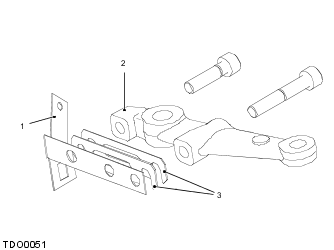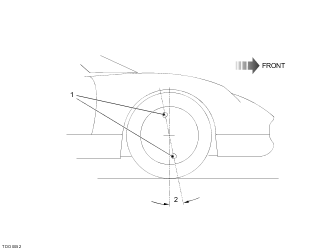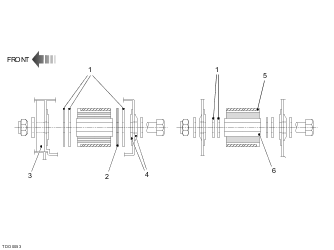Here are specs:
Adjusting Wheel Alignment
Wheel alignment refers to the parallelism of the wheels when viewed from above. The wheels are said to 'toe-in' when the wheel paths converge ahead of the vehicle and 'toe-out' when
they diverge.
To adjust wheel alignment:
-
Hold the track rod end using the flats provided and slacken the lock nut. Repeat for the opposite side;
-
Turn each track rod a similar amount. As a guide, turning both track rods by one quarter of a turn will alter overall toe-out by approximately 2.0 mm;
-
When adjustment is correct, hold each track rod end and tighten the lock nuts.
|
Description |
Front |
Rear |
Notes |
|
Toe |
+0.1 mm Nominal (-0.5 mm to +0.7 mm total) |
+3.0 mm Nominal (+2.4 mm to +3.6 mm total) |
Difference side/side 0.3 mm |
Wheel alignment and suspension geometry is set at the factory on an alignment rig. Subsequent full geometry checks are required only after extensive front suspension repair, if uneven
tire wear is evident or if steering difficulties are encountered.
|
|
WARNING: Geometry measurements must only be made using recommended equipment. |
NOTE: Before any measurements or adjustments are made, it is essential to set the vehicle to its ‘mid-laden’ ride height.
|
Description |
Front |
Rear |
Notes |
|
Ride Height |
5.12 in (130 mm) |
5.12 in (130 mm) |
Measured from ground to jacking points |
|
Camber |
-0.1° (+0.1° to -0.3°) |
-1.8° (-1.6° to -2.0°) |
Max. cross camber 0.2° |
|
Castor |
3.8° (3.5° to 4.1°) |
- |
Max. cross castor 0.35° |
Additionally, if it need any major adjustments it may require
shims, here is some information on that:
Wheel Alignment
Wheel alignment refers to the parallelism of the wheels when viewed from above. The wheels are said to 'toe-in' when the wheel paths converge ahead of the vehicle, and 'toe-out' when
they diverge.
Front Alignment
For further information on adjusting front wheel alignment, refer to
this information.
Rear Alignment
Rear wheel alignment is adjusted by slackening both ball joint lock nuts and turning the link rods as necessary to increase or decrease the effective length of the link. As a guide,
lengthening the link rod by one 'flat' (one sixth of a turn) will increase toe-in by approximately 1 mm. After adjustment, tighten the two lock nuts to 55 Nm taking care to ensure that the ball joint sockets are aligned at 90° to each other to allow some free
articulation.
Camber
Camber is the angle from vertical of the wheel when viewed from the front. Camber is negative when the wheel leans inwards at the top and positive when leaning outwards at the top.
The correct camber achieves maximum efficiency of the tire under cornering loads.
The primary purpose of camber is to achieve the maximum efficiency of the tire under cornering loads and body roll (the specification is closely allied to a particular wheel/tire combination).
The camber angle will change with suspension travel, becoming more negative on bump, and must be measured only at the specified ride height. Incorrect camber can result in handling deficiencies and excessive tire wear.
-
Wheel sensor bracket
-
Steering arm
-
Camber angle shims
Front camber geometry is set using an appropriate amount of 1 mm shims between the steering arm and upright assembly. Reducing the shim pack thickness will increase negative camber.
Adding shims plates will reduce negative camber. A 1 mm shim will alter camber by approximately 0.25°.
-
Wheel sensor bracket
-
Camber shims
-
Ball joint carrier
Rear camber geometry is set using an appropriate amount of 1 mm shims between the carrier and upright assembly. Reducing the shim pack thickness will increase negative camber. Adding
shims will reduce negative camber. A 1 mm shim will alter camber by approximately 0.25°.
Castor is the angle from vertical of the steering axis of the wheel when viewed from the side.
|
|
WARNING: Castor angle must only be checked or adjusted with the vehicle at the correct ride height. Refer to General for correct height
this
information.
.
|
-
Top and bottom steering swivels
-
Castor angle
The main purpose of castor is to provide a natural straight running tendency of the front wheels when the vehicle moves forward and determines the degree of self-centering. Castor angles
have a complex interaction with other steering geometries and, if unbalanced or outside of specification, can result in various stability and handling deficiencies.
Spacer washers are fitted ahead of, and behind, each of the top wishbone pivot bushes to allow the wishbone to be displaced forwards or backwards. This will effect a change of castor
angle.
A rubber-faced snubber washer fitted against the rear face of the top wishbone front bush prevents metal to metal contact under extreme braking forces. The spacer washers may be re-distributed
between the front and rear of each pivot bush but the snubber washer position and the total shim pack thickness of 1.5 mm (x4) at each pivot, including the snubber washer, MUST remain unchanged.
-
Castor shim washers
-
Snubber washer
-
Bonded plate
-
Bonded insert
-
Outer plastic sleeve
-
Inner steel sleeve
Shim washer distribution at the front bush of either wishbone must be copied at the rear bush of that wishbone. Transferring a 1.5 mm shim washer from ahead of, to behind, the pivot
bushes, will reduce castor by approximately 0.4°. Transferring a 1.5 mm shim washer from behind, to ahead of, the pivot bushes will increase castor by approximately 0.4°.
|
|
WARNING: Shim washer distribution at the front bush of either wishbone must be duplicated at the rear bush of that wishbone.
|
NOTE: Ensure that the load spreading washers are correctly located beneath the bolt heads and nuts as shown above.
NOTE: Ensure that the pivot bolts are tightened only with the vehicle at ride height.



